How to properly form a tomato bush: schemes for a greenhouse and open ground, tall and low-growing varieties
The formation of tomato bushes is one of the most important agricultural practices, thanks to which we can get the greatest yield.
About what exactly you need to do this, when and how to properly form tomato bushes - this will be the focus of our article.
There is nothing complicated about this, you just need to understand the essence of the procedures (removal of stepsons, leaves, pinching the top) and take action.
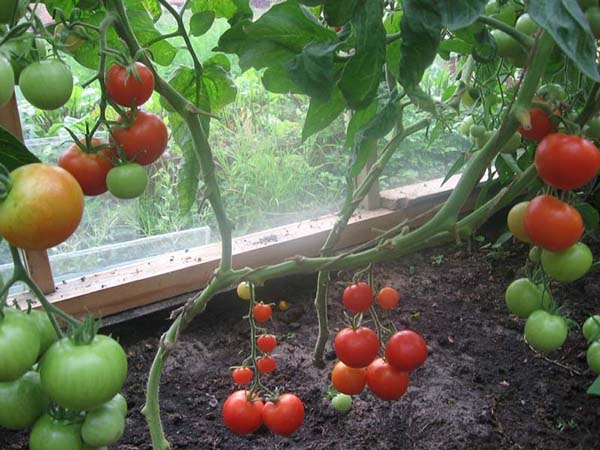
Content
- 1 What is the formation of tomatoes and what is it for
- 2 Formation of determinant and indeterminate tomatoes in a greenhouse and open field: which ones are needed and which ones may not be formed
- 3 How to shape tomatoes into 1 or more stems
- 4 Pruning leaves from tomatoes
- 5 Pinching the growth point of tall (indeterminate) tomatoes
What is the formation of tomatoes and what is it for
Tomatoes are a very bushy plant that is able to expel additional side shoots (stepchildren) from the axils of each leaf, on which new stepchildren grow in the future. And if you do not intervene in this process of free formation of a bush in time, then in a short summer, the plant will simply spend all its energy on the formation of shoots and leaves (green mass), and not on the growth and ripening of fruits, which means that you will not get a decent harvest ...
Thus, the formation of tomatoes includes the following main activities:
- pinning (removal of stepsons);
- removal of excess (lower) leaves;
- pinching of growth points (stem tops).
Stealing
By the way! In general, the terms "formation" and "pinching" are often used as synonyms. However, it is perhaps better to separate them, which is why on our website it was decided to highlight material about how to pinch tomatoes correctly in a separate article.
Formation of determinant and indeterminate tomatoes in a greenhouse and open field: which ones are needed and which ones may not be formed
All varieties and hybrids of tomatoes are divided into indeterminate (with unlimited growth) and determinant (with limited, they are also called undersized).
By the way! The site has separate detailed articles on what are indeterminate tomatoes, their best varieties, formation rules, and features of cultivation and varieties of determinant tomatoes.
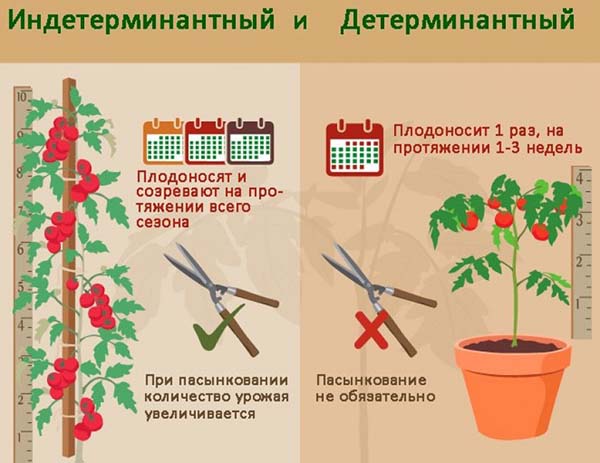
Indeterminate (tall) tomatoes need to be pinned necessarily and regularly, and they, as a rule, are grown = formed into 1 stem, i.e. constantly remove all stepsons.
Although in some cases, indeterminate tomatoes form in 2 (more often) and even 3 stems (very rarely).
But determinant (undersized) tomatoes, as a rule, have to be pinned much less often, although superdeterminant (dwarf and standard) tomatoes often do not need pinching at all.
Important! Nonetheless, to get the maximum yield, determinant tomatoes also need to be properly shaped. In the greenhouse, low-growing tomatoes are formed in 2-3 stems, and in the open field - in 1-2 stems.
Formation of indeterminate tomatoes
Basic rules for the formation of indeterminate tomatoes in a greenhouse and open field:
- The plant itself is formed mainly in one stem.
- However, it differs limiting the growth point and the number of fruit clusters... So, when growing 7 fruit brushes are left in the greenhouse by the bush, in the open field - 5.
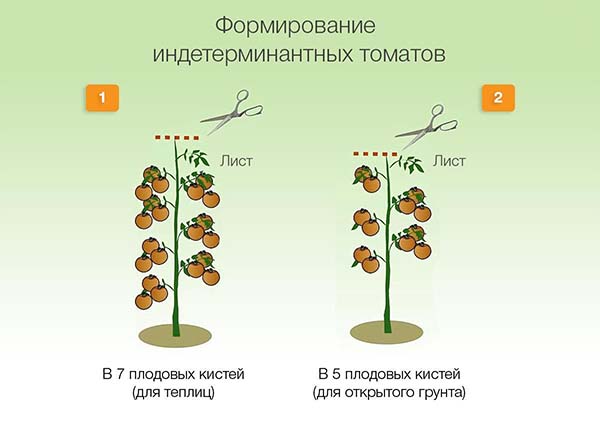
- But sometimes, but only in a greenhouse, tomatoes are formed into 2 stems.
Note! It is recommended to leave as 2 stems stepson, located under the first flower brush.
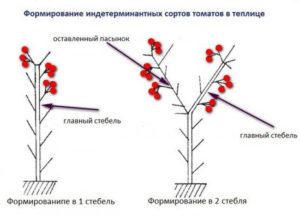
Video: the formation of tall tomatoes
Formation of determinant tomatoes
The main features of the formation of determinant tomatoes in open and closed ground:
- Determinant tomatoes in the open field, form into 1 stem, maximum - 2.A in the greenhouse — in 3 stems or in 2, with the transfer of the growth point to the lateral shoot (we can say that in 3):
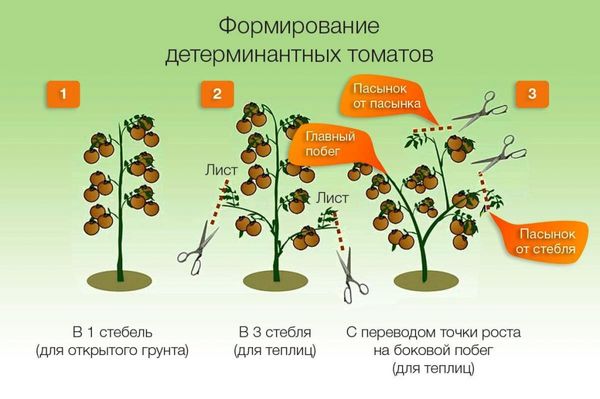
- And here superdeterminate tomatoes in the open field form into 2 stems (sometimes in 3), and in a greenhouse - 3 stems (and sometimes at 4).
By the way! Although it is dwarf standard tomatoes that can not be formed at all, because they themselves do not give many stepsons, and if they do, then just within 2-3.
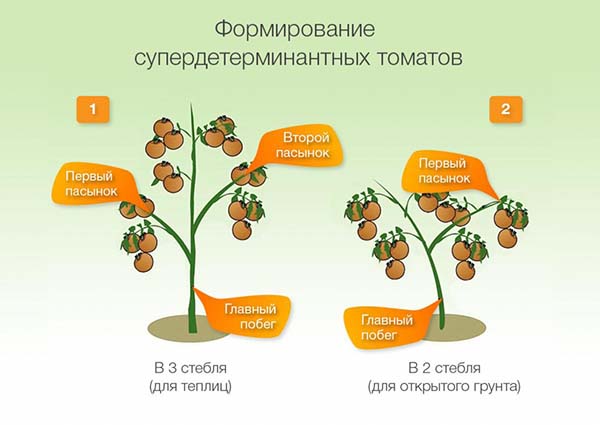
Video: determinant tomatoes - formation and care
Features of the formation of tomatoes in a greenhouse and open ground
As we found out above, the main thing that has a decisive influence on how you better shape tomatoes is their type, namely, whether they are limited in growth (determinant) or not (indeterminate).
In this way, indeterminate (tall) it is recommended to grow tomatoes in the greenhouse, a determinant (undersized) tomatoes are perfect for open ground.
Video: the formation of tomato bushes in a greenhouse
How to shape tomatoes into 1 or more stems
So, if you read the previous paragraph, you know that tomatoes, depending on their belonging to a certain type (determinant or indeterminate, because with limited or unlimited growth) and the method of growing (in open ground or greenhouse) can be formed in 1 , 2 or 3 stems.
Next, we will consider the nuances, advantages and disadvantages of the formation of determinant and indeterminate tomatoes in a greenhouse and open field in 1 or more stems.
Video: shaping a tomato in 1, 2 and 3 stems
Formation into 1 stem
Features of the formation of tomatoes in 1 stem:
- The essence of the formation of tomatoes in 1 stem is the removal of all stepsons from the main trunk.
- As a rule, indeterminate tomatoes are formed in 1 stem in the open field and in the greenhouse, while limiting the number of flower brushes in different ways (for OG - 5, for the greenhouse - 7).

Although determinate tomatoes in the open field can also be formed into 1 stem.
- It is best to form tomatoes into 1 stalk in a high greenhouse, which has a height of about 2.5-3 meters.
The main disadvantage of forming tomatoes into 1 stem is the fact that in this case you will need more seedlings than when forming into 2 stems.
Although outdoors, indeterminate tomatoes can only be grown in 1 stem.
Forming into 2 stems
The nuances of forming tomatoes in 2 stems:
- To form 2-stem tomato bushes, you need to leave a stepson under the first flower brush. It is usually the strongest and fastest growing. He will be your 2nd stem. All other side shoots (stepchildren) will need to continue to be regularly removed (pinned).
Interesting! Sometimes the plant bifurcates itself, in other words, it has a second strong shoot, and not necessarily just under the flower brush, maybe above it.
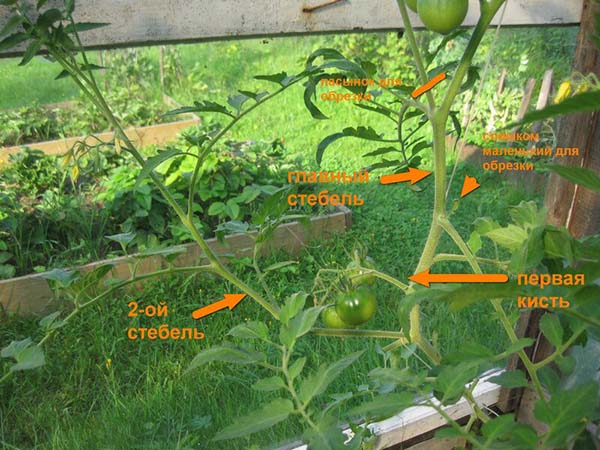
By the way! Including it is necessary to remove stepchildren, which will form on the 2nd stem.
- As a rule, indeterminate tomatoes are formed in 2 stems in the greenhouse, as well as determinant (especially superdeterminant) tomatoes in the open field and in the greenhouse.
- It is convenient to form indeterminate and determinant tomatoes into 2 stems in not very high greenhouses, 1.5-2.5 meters high.
Forming into 3 stems
- The essence of the formation of tomatoes in 3 stems is similar: as the 2nd stem, you need to leave a strong stepson under the first flower brush, and as the 3rd - either above first brush (undesirable)or below the 2nd stem (i.e. below it). And again, all the other stepsons will need to continue to be removed regularly.
Advice! Do not forget to remove stepchildren that will form on the 2nd and 3rd stems.

- As a rule, only determinant (undersized) tomatoes are formed in 3 stems in a greenhouse and open field.
Interesting! And you can also form initially in 2, and then in 3 stems, i.e. with the transfer of the growth point to the lateral shoot.

Little trick! In the case of determinate tomatoes, even if you form a bush of 3 stems, there can be only 3-4 brushes, although there should be 5-6 of them. Therefore, one more stepson should be left, i.e. shape into 4 stems.
Video: the formation of low-growing (determinant) tomatoes
The main disadvantage of the formation of medium-sized and tall tomatoes in 3 stems is that there is a significant thickening, which means that it becomes more difficult to care for (tie, pinch), and also to harvest. Therefore, this number of stems is left only when growing undersized tomatoes.
Pruning leaves from tomatoes
Gradually (when they are no longer needed by the plant), the lower leaves of the tomatoes should also be removed (in addition to the stepsons).
This primarily concerns indeterminate varieties and hybrids when growing them in a greenhouse. And read about the nuances of leaf removal in determinant and superdeterminant ones below.
So when the same remove bottom leaves at tomatoes?
- As a rule, the lower leaves on the stem begin to be removed gradually (1-2 pieces per week, but in no case 3-5 at a time, otherwise the plant will be in a state of shock) during the period of fruit formation. When the fruits on the first cluster are fully formed and begin to pour, by this time they should all be removed.
Important! You need to start removing the leaves from the lowest ones, especially if they suddenly began to fall and literally lie on the ground.
Moreover, you need to remove the lower leaves, if they are twisted into a tube, turned yellow.
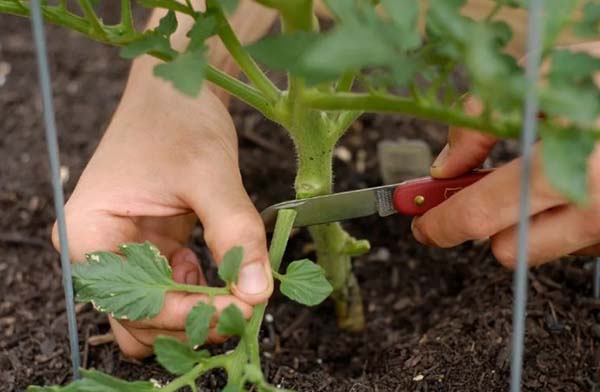
A when should delete (cut or trim) leaves above the first brush?
- Similarly, i.e. when the fruits are formed on the second hand, and so on.
However, the leaves above can not be completely removed, but the leaf itself can be cut in half - across the central vein.

Why delete leaves have tomatoes?
- So that the plant does not get sick with late blight if the lower leaves begin to fall on the ground.
In other words, if the lower leaves touch the ground, then they will become a conductor of diseases from the soil.
- For better ventilation (airflow) of the lower part of the bush.
- To accelerate ripening (the acquisition of fruits of a red or other color).
When are the lower leaves you can leave and not delete?
- In conditions of high humidity and waterlogging, due to frequent rains, the lower leaves can act as a buffer, intercepting moisture and thereby preventing cracking of fruits... Provided, of course, that they are healthy and not in contact with the soil.
- Also, do not remove the leaves when growing tomatoes in the open field, otherwise your tomatoes will simply burn the sun.
Note! Have determinant (undersized) varieties and hybrids of tomatoes leaves need to be removed, but in smaller quantities and only the lowest ones (which are close to the ground and can touch it), as well as dry, yellowed, painful.
And at superdeterminate tomatoes and it is practically not necessary to remove the leaves at all (except, again, dry, yellowed, in short, superfluous).
Video: when and how to trim the leaves of tomatoes
Pinching the growth point of tall (indeterminate) tomatoes
If determinant tomato varieties have growth restriction, then over time they completely stop growing, so to speak, "Do".
In this way, growth determinant tomatoes stops after laying 3-5 (in very rare cases - 6) flower brushes, the first of which is laid above 5-7 sheets, and all subsequent ones - every 1-2 sheets. Moreover, the latter is formed at the very top (therefore, they say "Bends"), and then the growth stops. Eventually the height of such a bushremains within 60-150 cm.
In indeterminate varieties there is no height restriction (height from 2 meters and above, but most often from 1.5 meters and above)so they are something look like vines, in other words, as long as there is an opportunity, they will grow up, while continuously forming flower brushes and side shoots (stepsons) on the stem... At the same time, the first flower cluster in such tomatoes is formed above 9-12 leaves, and all subsequent ones - after 2-3 leaves.

So when the liana will reach the top of the greenhouse either already the second half will come - the end of July - the beginning of August (the very time of the beginning of active fruiting), you will definitely need cut off the top-top = pinch the growth point, otherwise tomato, which there (in the upper part of the bush) will be tied, simply will not have time to ripen.
Important! You need to pinch the growth point after the last brush, leaving 2-3 leaves above it.
And this also applies to the 2nd and 3rd stems (former stepsons), if you formed several stems.
And there are also semi-determinant (medium-sized) varieties of tomatoes... In this type of plant, the stem height can reach 2 meters (within 150-200 cm). The maximum number of flower brushes is 9-12, which are formed after 2-3 leaves, starting also after 5-7 leaves.
However, such plants may unexpectedly restrict their growth after 3-4 clusters and "terminate" (as determinant). Therefore, they are most often formed into 2 stems, leaving the stepson who is under the first flower brush. As a result, it will become the new main stem, which will continue its development upward. However, it should be understood that in the end it must also "end".

Thus, now you know all the nuances of the correct formation of tomato bushes. You just have to apply the knowledge gained in practice and compare the result with what was earlier, when you were not yet aware of how to form tomatoes or did not do it quite right.
Video: forming tomatoes

